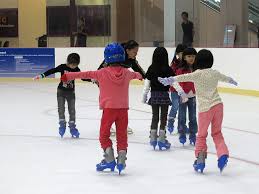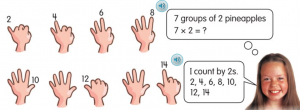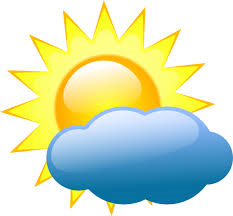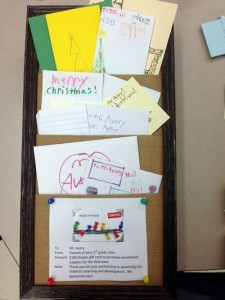Posted by kavery508 | Posted in Uncategorized | Posted on January 4, 2016
 Source:pixabay.com
Source:pixabay.com
Happy New Year! I hope your holidays and vacations were filled with joy. Thank you for all of the wonderful gifts, kind words, and large class gift card to Staples. I feel appreciated indeed!
We had a blast at our class celebration before vacation. It was a perfect way to honor our achievements supported by our caring classroom community. Thanks for your help with pajamas! It went so smoothly, we’ll have more of them in the future.
 Our reading comprehension focus this week is on Asking Questions and reading to look for answers. Now that the students are readers, their #1 job is to think while they are reading. Often though, we have to remind them to take meaning from reading, and asking questions is essential to that task–and sometimes it needs to be taught. After your child reads a page/part/chapter of a homework book, ask: What questions did you have while you read that? Did the author answer them? Did you have to infer the answer or did the author just state it? What questions do you have now about what you read? The Measured Mom blog has a nice think-through of these ideas, from pre-reading to “lingering questions” post-reading: http://www.themeasuredmom.com/questioning-a-reading-strategy-for-kids/
Our reading comprehension focus this week is on Asking Questions and reading to look for answers. Now that the students are readers, their #1 job is to think while they are reading. Often though, we have to remind them to take meaning from reading, and asking questions is essential to that task–and sometimes it needs to be taught. After your child reads a page/part/chapter of a homework book, ask: What questions did you have while you read that? Did the author answer them? Did you have to infer the answer or did the author just state it? What questions do you have now about what you read? The Measured Mom blog has a nice think-through of these ideas, from pre-reading to “lingering questions” post-reading: http://www.themeasuredmom.com/questioning-a-reading-strategy-for-kids/
 In writing, our focus is on stretching out the main event of a narrative such that it provides detail and description. Take a look at the “Gym main events” that will be coming home this week. These were done with individual teacher support, and represent the kind of stories we want kids to eventually own independently. Check out this example from Marlena, and notice how she puts the reader in the picture: I scrambled to the other team and plopped onto their mat. As I was looking across the gym, Anna slid a bean bag to me as fast as she could. I scooped up the blue bean bag and yelled, “Hurrah! I’m free!” This week students will write main events based on a memory from their holidays or vacation weeks, owning more of the process than before.
In writing, our focus is on stretching out the main event of a narrative such that it provides detail and description. Take a look at the “Gym main events” that will be coming home this week. These were done with individual teacher support, and represent the kind of stories we want kids to eventually own independently. Check out this example from Marlena, and notice how she puts the reader in the picture: I scrambled to the other team and plopped onto their mat. As I was looking across the gym, Anna slid a bean bag to me as fast as she could. I scooped up the blue bean bag and yelled, “Hurrah! I’m free!” This week students will write main events based on a memory from their holidays or vacation weeks, owning more of the process than before.
 Chapter 6 of MIF focuses on learning multiplication facts of 2s, 5s, and 10s by teaching the connection between skip-counting and multiplication, and using that understanding to solve problems. To solve 8 x 2, for example, we want students to count by 2 eight times. It is a way of learning the meaning behind the numbers involved in multiplication instead of just memorizing facts (which has value, too, just not on its own). One way we teach this is to have students count pairs of objects. Another is to hop by 2s up the number grid. Next is counting on fingers while counting aloud by 2 (1 finger up gives you 2, or 1 x 2; 3 fingers up gives you 6, or 3 x 2; etc.). Students will then be introduced to dot paper, which for this chapter shows arrays of 2s, 5s, or 10s. The example below shows 4 x 2.
Chapter 6 of MIF focuses on learning multiplication facts of 2s, 5s, and 10s by teaching the connection between skip-counting and multiplication, and using that understanding to solve problems. To solve 8 x 2, for example, we want students to count by 2 eight times. It is a way of learning the meaning behind the numbers involved in multiplication instead of just memorizing facts (which has value, too, just not on its own). One way we teach this is to have students count pairs of objects. Another is to hop by 2s up the number grid. Next is counting on fingers while counting aloud by 2 (1 finger up gives you 2, or 1 x 2; 3 fingers up gives you 6, or 3 x 2; etc.). Students will then be introduced to dot paper, which for this chapter shows arrays of 2s, 5s, or 10s. The example below shows 4 x 2.
A note about arrays: Arrays are rectangular arrangements of objects like the dots in the picture above. For our purposes, we always count the number of rows first and multiply that by the number of things in each row (columns). In this example, we are looking at a 4 x 2 array (read ‘4 by 2’), the total of which is 8. We can also turn the array on its side like this:
 This is a 2 x 4 array, with the same total as 4 x 2. We use these rotating arrays to teach students the commutative property of multiplication. If we know 4 x 2 = 8, then we immediately know that 2 x 4 = 8. There is no need to do the math a second time, and now we’ve learned 2 math facts at once.
This is a 2 x 4 array, with the same total as 4 x 2. We use these rotating arrays to teach students the commutative property of multiplication. If we know 4 x 2 = 8, then we immediately know that 2 x 4 = 8. There is no need to do the math a second time, and now we’ve learned 2 math facts at once.
When drawing arrays to solve problems (e.g. on classwork or homework), it is especially important that students draw them correctly. A problem about 3 bags of 8 tennis balls (3 x 8) must have an array of 3 rows with 8 in each row, not the other way around. Even though the product of 8 x 3 is also 24, students must show they understand the numbers and arrangement of those numbers in the problem, to be correct. For some fun ways to notice and use arrays at home and while shopping, etc., check out this page from Brainpop: https://educators.brainpop.com/lesson-plan/arrays-activities-for-kids/
 As we continue our exploration of weather, students will conduct daily observations of temperature, clouds, and weather type over the next month. We will then analyze the data, look for trends, evaluate methods for presenting data (e.g. bar graphs vs. pie charts for example), and draw conclusions of winter weather in Shrewsbury. In addition, this week we will conduct a further investigation into evaporation designed to test the idea that all liquids evaporate the same way that water does. We will also learn to identify cloud types and use that to predict the weather. Weather Wiz Kids is a fantastic site for learning more about and all things weather. And here’s a perennial favorite, Bill Nye the Science Guy, teaching about how clouds are formed.
As we continue our exploration of weather, students will conduct daily observations of temperature, clouds, and weather type over the next month. We will then analyze the data, look for trends, evaluate methods for presenting data (e.g. bar graphs vs. pie charts for example), and draw conclusions of winter weather in Shrewsbury. In addition, this week we will conduct a further investigation into evaporation designed to test the idea that all liquids evaporate the same way that water does. We will also learn to identify cloud types and use that to predict the weather. Weather Wiz Kids is a fantastic site for learning more about and all things weather. And here’s a perennial favorite, Bill Nye the Science Guy, teaching about how clouds are formed.




